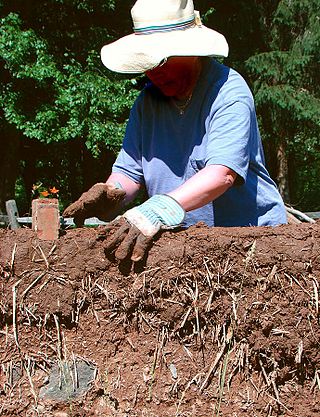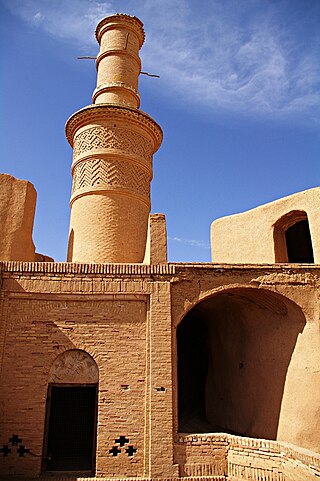
Adobe is a building material made from earth and organic materials. Adobe is Spanish for mudbrick. In some English-speaking regions of Spanish heritage, such as the Southwestern United States, the term is used to refer to any kind of earthen construction, or various architectural styles like Pueblo Revival or Territorial Revival. Most adobe buildings are similar in appearance to cob and rammed earth buildings. Adobe is among the earliest building materials, and is used throughout the world.

An earth shelter, also called an earth house, earth bermed house, or underground house, is a structure with earth (soil) against the walls, on the roof, or that is entirely buried underground.

A dome is an architectural element similar to the hollow upper half of a sphere. There is significant overlap with the term cupola, which may also refer to a dome or a structure on top of a dome. The precise definition of a dome has been a matter of controversy and there are a wide variety of forms and specialized terms to describe them.

Cob, cobb, or clom is a natural building material made from subsoil, water, fibrous organic material, and sometimes lime. The contents of subsoil vary, and if it does not contain the right mixture, it can be modified with sand or clay. Cob is fireproof, termite proof, resistant to seismic activity, and uses low-cost materials, although it is very labour intensive. It can be used to create artistic and sculptural forms, and its use has been revived in recent years by the natural building and sustainability movements.

The Aga Khan Award for Architecture (AKAA) is an architectural prize established by Aga Khan IV in 1977. It aims to identify and reward architectural concepts that successfully address the needs and aspirations of Muslim societies in the fields of contemporary design, social housing, community development and improvement, restoration, reuse and area conservation, as well as landscape design and improvement of the environment.

An Earthship is a style of architecture developed in the late 20th century to early 21st century by architect Michael Reynolds. Earthships are designed to behave as passive solar earth shelters made of both natural and upcycled materials such as earth-packed tires. Earthships may feature a variety of amenities and aesthetics, and are designed to withstand the extreme temperatures of a desert, managing to stay close to 70 °F (21 °C) regardless of outside weather conditions. Earthship communities were originally built in the desert of northern New Mexico, near the Rio Grande, and the style has spread to small pockets of communities around the globe, in some cases in spite of legal opposition to its construction and adoption.
Earthbag construction is an inexpensive building method using mostly local soil to create structures which are both strong and can be quickly built.
The architecture of the California missions was influenced by several factors, those being the limitations in the construction materials that were on hand, an overall lack of skilled labor, and a desire on the part of the founding priests to emulate notable structures in their Spanish homeland. While no two mission complexes are identical, they all employed the same basic building style.

Indo-Islamic architecture is the architecture of the Indian subcontinent produced by and for Islamic patrons and purposes. Despite an initial Arab presence in Sindh, the development of Indo-Islamic architecture began in earnest with the establishment of Delhi as the capital of the Ghurid dynasty in 1193. Succeeding the Ghurids was the Delhi Sultanate, a series of Central Asian dynasties that consolidated much of North India, and later the Mughal Empire by the 15th century. Both of these dynasties introduced Islamic architecture and art styles from West Asia into the Indian subcontinent.

An earth structure is a building or other structure made largely from soil. Since soil is a widely available material, it has been used in construction since prehistoric times. It may be combined with other materials, compressed and/or baked to add strength.
Nader Khalili was an Iranian-born American architect, author, and educator. He is best known for his inventive structures that incorporated a range of atypical building materials to provide shelter in the developing world and emergency contexts. His work was heavily influenced by the traditional arid house designs of Iran.
Ceramic houses are buildings made of an earth mixture which is high in clay, and fired to become ceramic. The process of building and firing such houses was developed by Iranian architect Nader Khalili in the late 1970s; he named it Geltaftan. "Gel" means "clay" and "taftan" means "firing, baking, and weaving clay" in Persian language. Khalili's research into creating ceramic houses was strongly based on the idea that permanent, water-resistant, and earthquake-resistant houses could be built with the implementation of the four elements: earth and water to build the forms, and fire and air to finish them. His impassioned work led to a few small scale projects in Iran, including the Javadabad Elementary School, and the Ghaled Mofid restoration project. Aside from Khalili's own documented work, there seems to be little widespread research on ceramic houses.
The history of construction traces the changes in building tools, methods, techniques and systems used in the field of construction. It explains the evolution of how humans created shelter and other structures that comprises the entire built environment. It covers several fields including structural engineering, civil engineering, city growth and population growth, which are relatives to branches of technology, science, history, and architecture. The fields allow both modern and ancient construction to be analyzed, as well as the structures, building materials, and tools used.

The Roman architectural revolution, also known as the concrete revolution, is the name sometimes given to the widespread use in Roman architecture of the previously little-used architectural forms of the arch, vault, and dome. For the first time in Europe, possibly in the world, the potential of these elements was fully appreciated and exploited in the construction of a wide range of civil engineering structures, public buildings, and military facilities. Throughout the Roman empire, from Syria to Scotland, engineers erected structures using semicircular arches. The first use of arches was for civic structures, like drains and city gates. Later the arches were utilized for major civic buildings bridges and aqueducts, with the outstanding 1st century AD examples provided by the Colosseum, Pont Du Gard, and the aqueduct of Segovia. The introduction of the ceremonial triumphal arch dates back to Roman republic, although the best examples are from the imperial times.

Vigas are wooden beams used in the traditional adobe architecture of the American Southwest, especially in New Mexico. In this type of construction, the vigas are the main structural members carrying the weight of the roof to the load-bearing exterior walls. The exposed beam-ends projecting from the outside of the wall are a defining characteristic of Pueblo architecture and of Spanish Colonial architecture in New Mexico, often replicated in modern Pueblo Revival architecture. Usually the vigas are simply peeled logs with a minimum of woodworking. In traditional buildings, the vigas support latillas (laths) which are placed crosswise and upon which the adobe roof is laid, often with intermediate layers of brush or soil. The latillas may be hewn boards, or - in more rustic buildings - simply peeled branches. These building techniques date back to the Ancestral Puebloan peoples of 750 to 1300 CE, and vigas are visible in many of their surviving buildings.
The 1972 Qir earthquake occurred at 05:36 local time on April 10, 1972. It had a magnitude of 6.7 on the moment magnitude scale and a maximum perceived intensity of IX (Violent) on the Mercalli intensity scale. The epicentre was in the province of Fars in southern Iran. The earthquake caused the destruction of Qir and serious damage to towns and villages in the surrounding area. The estimated number of deaths is 5,374, with a further 1,710 injured.

Musgum mud huts or Musgum dwelling units are traditional domestic structures built of mud by the ethnic Musgum people in the Maga sub-division, Mayo-Danay division, Far North Province in Cameroon. Referred to in Munjuk as Tolek, the dwellings are built in a variety of shapes, such as tall domed or conical dwellings or huts, some with a reverse-V shape, and others with geometric designs.

Cultures from pre-history to modern times constructed domed dwellings using local materials. Although it is not known when or where the first dome was created, sporadic examples of early domed structures have been discovered. Brick domes from the ancient Near East and corbelled stone domes have been found from the Middle East to Western Europe. These may indicate a common source or multiple independent traditions. A variety of materials have been used, including wood, mudbrick, or fabric. Indigenous peoples around the world produce similar structures today.

Contained earth (CE) is a structurally designed natural building material that combines containment, inexpensive reinforcement, and strongly cohesive earthen walls. CE is earthbag construction that can be calibrated for several seismic risk levels based on building soil strength and plan standards for adequate bracing.

Majara Residence is a seaside accommodation complex in the island of Hormuz in the Persian Gulf, South of Iran. The building consists of 200 colorful domes of varying sizes and shapes built with the participation of the local population of the island, using the Superadobe sandbag technique. The domes, some of them interconnected, contain both accommodation and public facilities such as restaurants and cafes. Majara, as the first major eco-touristic hotel on the island, was completed in 2020. It is designed by the Tehran-based architectural firm ZAV Architects and since its completion, it has been recognized internationally with several awards.














